|
Tough Breaks |

|
|
By David "Shorty" Routh - Phoenix, Arizona - USA |
Some people put fiberglass on the bottom of their masts, some don't, and some glass their mast all the way to the top. I was wondering if the fiberglass was a waste of time & money, or if it really helps strengthen the mast. This is an experiment that I did to try and get some data, to help answer this question.
Forces At Work
The hull, ballast & crew are trying to keep the mast upright while the wind blows against the sail trying to push the mast over, and all of that force is focused at the mast partner like a large lever arm. The maximum force the mast experience is the force it will take to push the boat over. So the wider & larger your hull is, and further you hike, the stronger of a mast you will need.
Most unstayed masts are tapered, being fat at the bottom and skinny at the top. The further up on the mast you go, the less and less force is working on it so that the very top of the mast is almost just there to hold up the top corner of the sail.
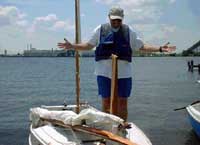 |
My friend Tim Webber on his Bolger Micro which did have a 3" diameter mast.
(click images for larger views) |
|
The picture above is a Bolger Micro which had a 3" diameter mast. It was broken on a windy day, and the break occured right at a knot, so it isn't really a fair example to see if it was a big enough mast for that boat. Other Micros have sailed around just fine with the same sized masts. One thing to point out is that when masts break, they usually are not very dangerous events, the sail and rigging usually go over the side or forward, and don't endanger the crew in the cockpit. They only general exception to this is with stayed masts when the forestay breaks. The side stays usually do a good job of guiding the mast down directly onto the cockpit.
First I made up several test pieces, all the same thickness from the same piece of 2x4. They were each ripped one after the other, and there were no knots in the wood.
| From top to bottom:
-
plain stick for measuring he bending angle
-
2 layers of 6oz fiberglass
-
1 layer of 6oz fiberglass
-
just epoxy
-
plain board
|

|
|
| 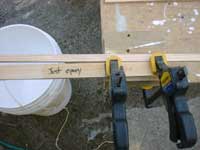
|
Each board was clamped to a work table in the same place, so that the same amount was hanging over the side. |
|
| I suspended a large bucket on the end of the test stick, and began to fill it with water.
|
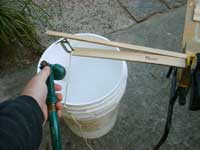
|
|
| 
|
As the bucket filled, I measured the distance the test piece was bending.
|
|
| Finally when it would break, I would stop filling the bucket and measure how many vertical inches of water were in the bucket.
|
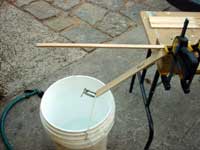
|
|
| 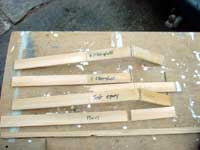
|
Results
| Sample |
Bend |
Water |
| plain |
6" |
4-7/8" |
| epoxy |
6.5" |
6-1/8" |
| 1 glass |
6-3/4" |
5-3/8" |
| 2 glass |
7-1/2" |
6-3/4" |
|
|
As you can see, the samples with the fiberglass could bend a lot more
before breaking, and took more weight to finally break. There are
plenty of flaws with this experiment like the very small sample size,
and that the glassed pieces were thicker than the plain wood piece.
Good enough results for me though, I am sold on glassing the lower 30%
of my masts. Plus regardless of the strength tests, fiberglass &
epoxy will protect the mast from things like UV, rotting, scratches,
nicks etc, so since it is so cheap anyway, it is probably a good idea
to go ahead and use the glass.
The Next Experiment
I am curious if the breaking strength increases in a linear fashion, the larger the mast gets.
The experiment I am thinking of would be to take 1/4" stick and break it the method shown above.
Then break a 1/2" stick, a 3/4" stick, and keep going up.
Do this with atleast 5 of each size stick to make sure that there isn't a problem with with wood used.
Chart the results and see if they are linear to see what it would take to break a full sized 2.5" diameter mast.

Other articles by David "Shorty" Routh:

|